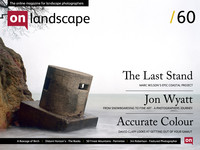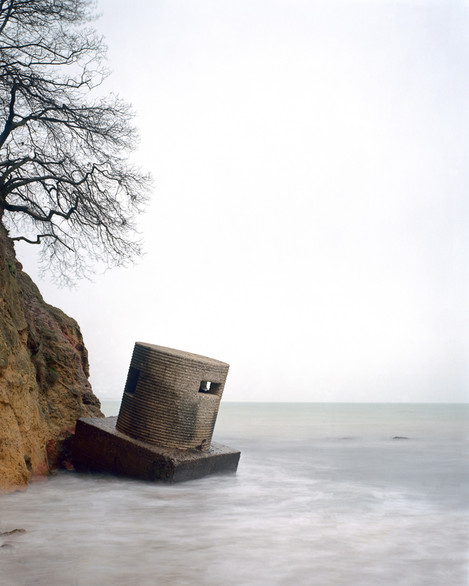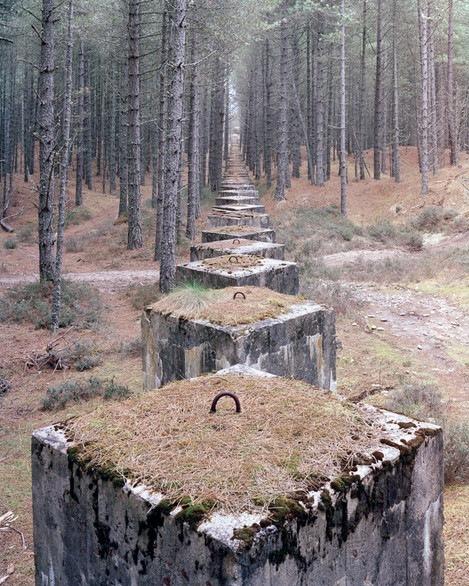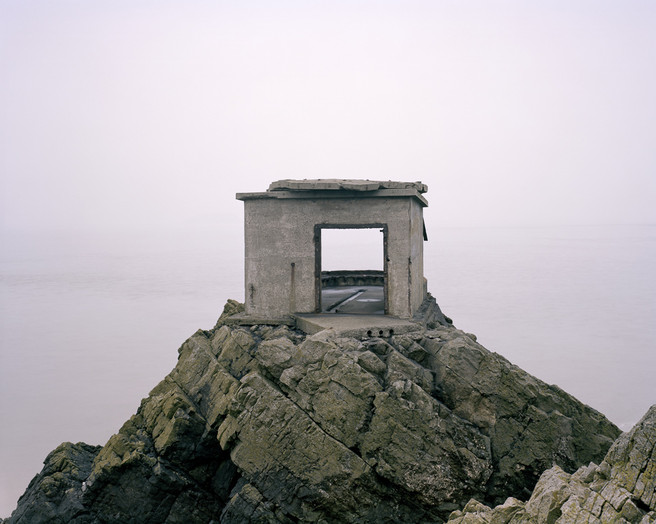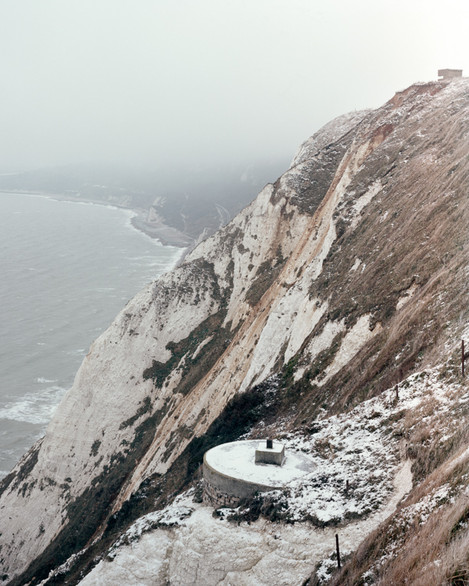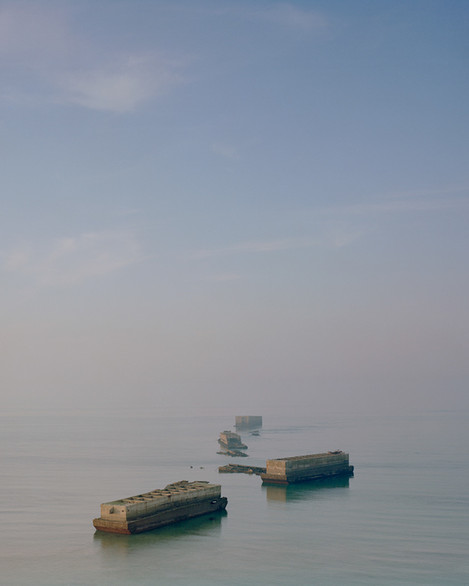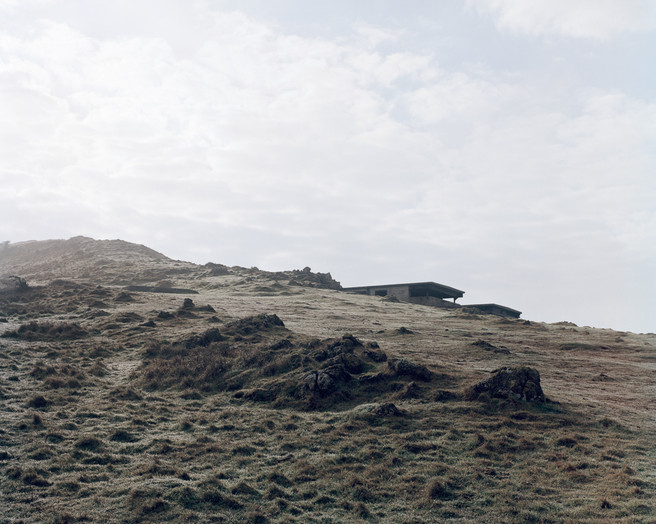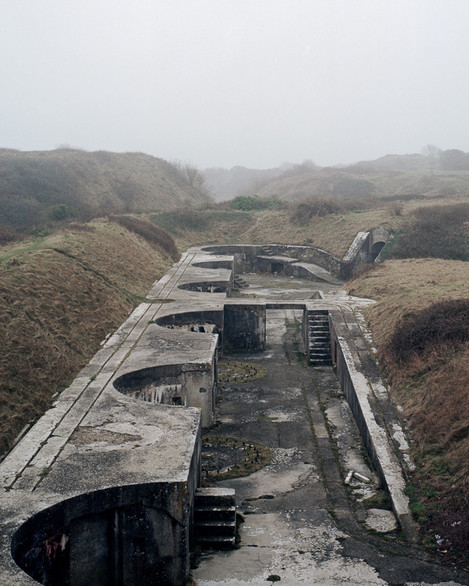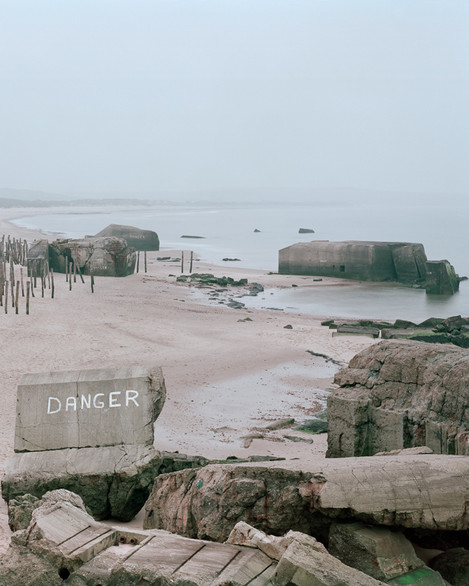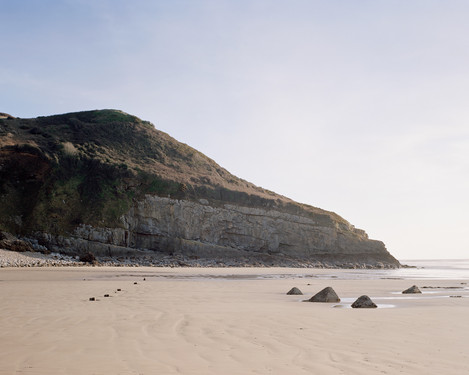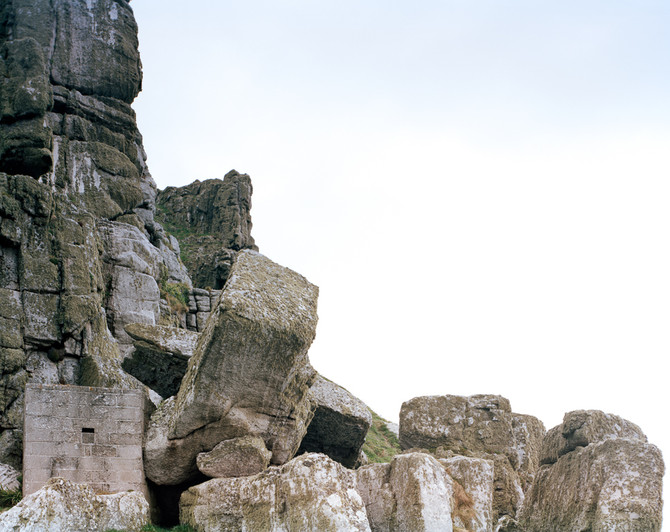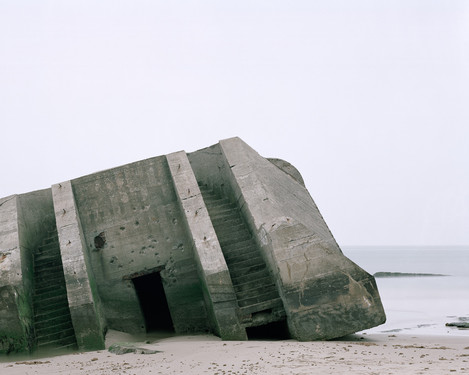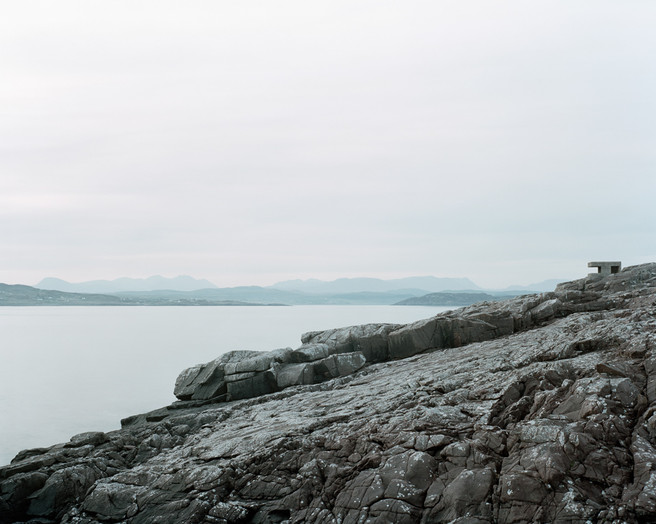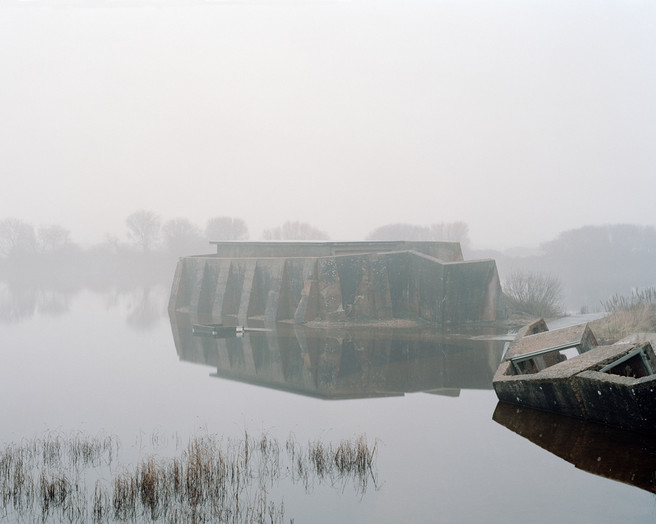Marc Wilson

Tim Parkin
Amateur Photographer who plays with big cameras and film when in between digital photographs.
We visited Marc Wilson at the Royal Armouries at Fort Nelson in Portsmouth and he spared us some time for a video interview. We've also transcribed the interview below the video.
Video
Transcription
Tim: Marc, welcome to On Landscape.
Marc: Thanks.
Tim: We’re here in the Royal Armouries at Fort Nelson in Portsmouth and we have a back drop of your exhibition. So can you tell us a little bit about the project and where it started?
Marc: The project is called "The Last Stand", as you probably know already. The project started about three years or so ago with the kind of research stage and then the photography stage came after that. But the initial idea actually came out of other work I did about eight or nine years ago which was called "Abandoned", which led to places that had some social or political or historical significance and memories, stuff like that. Looking back on some of the images from that work I found myself lingering on the images that had military significance to them as well, so I started looking back into that subject and the more I read into it, and the more I learnt about the subject, the more I realised it was a story that I wanted to tell.
Tim: Have you got a link with the military in any way?
Marc: No I don’t, I don’t have any. I think like most people I have some family background, I think we’ve all got family background, however many generations you go back will have a military past but I don’t have any big historical background, I don’t have a military background in that way. I've never been particularly interested in military things as such, but i saw this as a wide subject and such an important story to tell, and I've obviously learnt more and more as I've done the project. The more I've learnt, the sadder I have become in a way, the stories I have heard, the tragedies I have read about and so it's become more and more important to do, I think.
Tim: Yeah. So you're a professional photographer. Did you do a degree in art or?
Marc: Yeah, I actually did a sociology degree first.
Tim: Right, okay.
Marc: And then, probably like most people, I finished that and thought what do I do with that?
Tim: Yes.
Marc: I liked taking pictures so I then did a photography degree and afterwards an MA in photography as well. Yeah, so I'm quite well educated that way.
Tim: How did that go? I mean: is that what you expected it was going to be when you started?
Marc: Yeah, I mean the degree was great because I went into it a little bit older than most students, so I knew exactly what I wanted to do. I found that the work I did was kind of quite sociology based, which I guess this is as well. I left college and I never wanted to be a commercial photographer, I only wanted to have a fine art practice and, yeah, I tried doing that by itself and did lots of teaching as well at the time. And then I started shooting commercially about five or six years ago.
Tim: So when did you graduate from your -
Marc: Oh.
Tim: Bit of a rude question!
Marc: No, it's alright actually, I should have planned for that, I want to try to remember. I graduated from LCP, which is LCC now. I think I first graduated in ’96, ’95, ’96 and then my MA was ’98-2000
Tim: So you were just starting the Abandoned project just after you finished your MA, is that right?
Marc: Yeah, that was just – I did one small piece of work after the MA and then the "Abandoned" project after that.
Tim: In terms of planning the projects, you obviously had a couple of photographs of places on which to base it. Which were the original photographs?
Marc: They're not in here at all.
Tim: They're not in the exhibition?
Marc: No, no, no. That was more kind of inspiration for the project to get me going. So this is all new work. It's basically research really, lots and lots of research. It was general internet, text and image based research, you know, through Google to start with and then finding lots of locations and then starting to look into details of those locations to see which ones would be of interest to the whole project in terms of the stories and the histories and memories behind them. But also as a photographer in terms of the imagery, you know, what I think would make interesting imagery for people to look at.
Tim: So what's the story? I mean how did you envisage the story developing? Did the idea from the project come whole to begin with or?
Marc: Yeah, it was whole. It started off as 20th Century coastal defences, military defences, it was always going to be coastal, it was a way of kind of compacting the project in a way. There's so many defences left all over the country and in Europe that I think unless I put some kind of barrier or board around it it was going to be impossible to kind of choose what to shoot in a way. It would be a bit of a random project. So there's that idea of coastal defences, and also what was interesting with that to me is how the landscape came into it. Coastal erosion over time and the intervening 70, 80 years has had a big effect on the landscape itself but also on the, you know, the subject matter as well.
Tim: Yeah.
Marc: So I was choosing that content in that way. The overall story was there although it did end up going from 20th Century defences to Second World War defences. Mainly because it ended up that all the ones I was shooting ended up being Second World War, apart from a couple of First World War, so it just seemed, you know, the correct thing to do.
Tim: Yeah. Were there many First World War defences?
Marc: There's some but not as many so it seemed like this was a better way to produce a project. It was that bit more coherent really.
Tim: Now I imagine some of them were fairly obvious but did you find any that were quite obscure?
Marc: Yeah. I mean I tried to – There's obviously a lot more defences than I photographed. I'm not cataloguing them as such, it's more of a visual document I think. There's some I found that I didn’t want to go to because they were too well known, like the Old Sound Mirrors down near Dungeness. It's just too - people go there, they’ll know all about them already and to me it's quite interesting to find subject matter and objects that people know less about, and are maybe a bit subtler, a bit less well known and so people need to learn about them and learn about the histories there. But then again, some of the locations I went to are quite well known histories because i just can't ignore them.
Tim: In terms of approaching the subject, once you’ve done your research and you’ve said ‘These are the places I want to go’, how do you work out what the photograph is going to be? Are you reacting to the location mostly or?
Marc: Yeah. I did a kind of minimal amount of research on each location to start with because I knew that to do full in depth research for each one would take a huge amount of time so it was more the case that I'd wait to do the full research until I had edited images for an exhibition such as this. So based on my small research I went to these locations. There's 43 images in the project so far. If I remember correctly I visited about 120, shot about 80 or so. There were some I'd go to and I'd arrive and find that the imagery wasn’t going to work. Or there were some I'd get to and the imagery that I thought was going to work wouldn’t, but I found other things there as well which worked better. Some I went to with visuals in mind and others were more reaction images. It wasn’t so much a reaction to the story behind it because the story is quite fixed. I think what's visually interesting to me is the way things have changed over time, so it's more of a reaction to the object in the landscape. It's very important to me not to simply document the objects themselves with nothing around them, you know, because then it becomes just a record of these things. It was important for me to document them within the landscape.
Tim: It's almost their sociological context.
Marc: Exactly and it is because it's about the histories and memories and the people that were in these locations, so showing the landscape was really important, and that would allow you to show how the landscape changes over time and how these objects sit within the landscape. They're not seen as military objects now necessarily, they're seen as objects in a landscape so it's very important to me to visualise them in that way.
Tim: So talk me through a day because I imagine you’ve been very busy. Would it be one location in a day or quite often doing quite a few?
Marc: It would depend. The first shot I did was in November 2010 in Norfolk and that image isn't here.
Tim: Right.
Marc: It would depend on the location. At first because of the funding it was kind of using bits of money as I had it here and there. I'd find that I'd shoot locations within a day's drive so I'd leave incredibly early and shoot that day or I'd stay overnight so I'd do kind of one or two days maximum. And then the longer trips which would involved European trips and up to the North West of Scotland, that was a case of getting more funding for that.
Tim: So the funding, you originally started with your own funding or did you get a grant?
Marc: I started with my own funding and then I ran a crowd funding campaign.
Tim: So that was the first set of funding was it? Was that Kick-Starter?
Marc: It was Indigogo. I looked at the crowd funding platforms available. Perhaps Kick-Starter would have been better at the time but -
Tim: It was US only wasn’t it.
Marc: It was US only. I think that’s changed now, you can do it in the UK.
Tim: It has, just recently.
Marc: I think in those days you had to have a US bank account. You could run it from the UK but you had to have a US bank account.
Tim: So how did Indigogo work? What happened there?
Marc: It worked really well, you know, I looked around at other profiling campaigns and tried to work out what worked and what didn’t. I actually found another photographer who was running a small campaign himself on a different platform. I wanted to see what the process was so that if you funded something, what will happen.
Tim: Yeah.
Marc: So I funded his project and I was very disappointed in what I got back, not as in physically what I got back but I got nothing. I didn’t get an email back, I didn’t get a ‘Thank you’, nothing at all and I was quite surprised.
Tim: Oh, you were paying somebody else for something?
Marc: Yeah. Because I would have really assumed, you know, and this is how I knew I'd want to run my one, I would assume that if you contribute to someone you’d have an email within a day at least, you know. Or something saying, ‘Sorry, I can't back to you, I’ll get back to you tomorrow’. Saying, ‘Thanks very much, this is great. This is what's going to happen with the project’. I didn’t get that and I found that quite strange. So I learnt quite a lot just on that small thing, how important it was that when I did run my campaign it was important to constantly engage with my audience. Because, you know, after all in a way these people are becoming my clients because they were paying towards the project's completion. They were getting rewards for it which is part of crowd funding but I think the main reason people contribute to crowd funding is that they want to see a project completed, so I felt they were my clients so I would constantly engage with them and update them as much as I could. You know, in terms of simply as soon as I knew they’d contributed money, wherever I was, whether it was on my computer off my phone, I'd make sure I'd write them an email, just saying, ‘Thanks so much for your contribution, gratefully received, really helpful. I’ll get back to you later with more details about the project’. That was important.
Tim: And presumably they're your future patrons really aren't they.
Marc: That’s exactly it. You know, when I went into the crowd funding I thought what you’ll get out of this is the money that comes in allows you to complete your project and that’s it but it's not, the bi-product is much larger in that you have this audience for your work. They really appreciate what you're doing and they're your audience for your next project and your next project, your next project. And the audience builds and builds and builds and people then contributed that first campaign maybe with $15 or $20, they’ve since brought prints, you know. So it works really well.
Tim: Because they're engaged with the project.
Marc: Yeah, they're engaged with the project.
Tim: You’ve recently had a couple of nightmares in France I believe with placements going missing?
Marc: Yeah, it's an odd one. It was actually the night after the opening of the army show here of an image from the northern coast of France. It's actually the shortest crossing between England and France and apparently where Julius Caesar embarked on his invasion of Britain many, many years ago... but I found out [the gun emplacements] had been removed by the French authorities on health and safety grounds
Tim: Oh right, because they were dangerous -
Marc: Yeah, I think some kids had been injured because, you know, you get lots of rock pools forming underneath. I can see that to a point but for me it's kind of erasing history to a point and I can understand why there's some people that maybe don’t want physical reminders of their past because it's a past they don’t want to be reminded of for whatever reason. My point of view as an individual, not as a photographer but as an individual, is that you have to remember your past. You can't erase your past, however difficult it is for you, because that’s the only way that you can remember it and then learn from these mistakes and protect the future. As a photographer my job isn't to be that subjective in that way, I don’t think, although you can't help but be subjective with the way you point your camera etc.
Tim: Yes.
Marc: My job is to put the imagery out there and then let people come to these conclusions and decisions and conversations themselves. But it also brought things into sharp focus. I really want to complete the project now as well because, as far as Northern Europe’s concerned, it's only about half way there at the moment.
Tim: Right, so how many have you got to look at in Northern Europe?
Marc: Well I still need to photograph the West Coast of France down to the Spanish border and then Denmark, Norway and then the Orkney and Shetland Islands up in Scotland.
Marc: Yes, they're fair distances to travel for that and I mean so far it's taken about three and a half years, it's cost about six and a half thousand pounds and about 60-, 70% of that has come from my own funding and the rest from crowd funding. I've travelled about 11,000 miles so far.
Tim: I can imagine, yeah.
Marc: So still lots of miles to travel.
Tim: You’ve shot it all with a large format camera. Is there a particular reason for that? Is that part of a legacy from your work at art college?
Marc: It's practical really. For the kind of photography I do and the imagery here I need to have the camera movements, it's really important just to shift. I never use tilt, it's just shift. You know, if you're shooting from low down or high up it's imperative.
Tim: For architectural subjects.
Marc: Architectural, yes. And then the reason for using 5x4 as opposed to like a digital camera shift lens is just the quality of the image, you know, because I know that I want to print large and I want to get the tones in the image. I shoot ] with shift lenses for my commercial work and I've looked at the difference in quality and for me at the moment the 5x4 just works better.
Tim: Yeah, yeah. And I suppose in the context of art as well it's still very popular – for the large prints and for the landscapes.
Marc: Yeah, I think it is and I guess it suits the subject matter as well. It's a very considered subject matter, it's not something you can rush into. Apart from the hours of research once you get to the location, whether it's a two hour or a 24 hour drive and a couple of nights in a motel etc., the subjects have to be treated with real sensitivity so to me the idea that I'm working on one frame at a time and I'm behind the glass screen and I've got the hood over my head. It suits the subject matter.
Tim: Yeah.
Marc: It's a kind of a cost thing as well I guess. given 15, 20 grand I could have a digital back on a 54 camera and I'd happily shoot that way but it's just not cost effective at the moment.
Tim: Yeah. What have your worst and best experiences been in this project so far in terms of running it as an art project.
Marc: It's difficult. I mean people have asked me which is my favourite image for instance and I've never been able to answer that question because I find it almost wrong if I had a favourite image in a large body of work, especially given the subject matter. I think the best experience for me comes when I engage with people. You know, I enjoy the process of photography as a photographer, I enjoy the shooting processes, it's great, I feel very lucky, but I think it's when I have conversations about it, when I speak to war veterans who were there at these locations, or I speak to serving officers in Afghanistan about it, they talk to me about it and I feel very humble when they congratulate me on what I'm doing. And then some people want their grandkids to come along and look at the work so they can tell them stories about what they did during the war in front of my pictures. I think for me that’s the best part of the work really. The worst part of it, I mean it's quite difficult, there's long travelling and lots of early mornings but that’s part of the job really. I think the worst part is if I couldn’t carry on, I couldn’t finish the work because it's a story that’s been told before obviously but I like to believe I'm telling it in a way that will allow people to interact with it slightly differently.
Tim: I suppose knowing some of these things have been destroyed or removed does add a slight amount of stress on top of it
Marc: Yeah. When I left the private viewing here I heard about some certain defences being destroyed. I was driving bath to Bath at the time, but I had this sudden panic that I had to go and shoot them tomorrow or the next day or the next day, although I was sure I'd got some months. In some cases there's years left to shoot this project. I've always wanted to complete it and I always thought I'd have years to complete it but I feel there is a bit more of an urgency now. there's that legacy of well, if one set of defences are removed, it sets a precedent and another one could be removed and another one and I know there's talk of doing the same in Denmark as well.
Tim: Yeah. Are you talking to them to try and find out if there's any about to go on?
Marc: I've got most locations I need to shoot now but until I have the funding to shoot it it's kind of pointless doing stuff because, you know, it takes a lot of money to go and shoot these things. I'm actually running a second crowd funding campaign which is going to start next week on emphasis.
Tim: Yeah, which we’ll make sure we’ve got it on the website.
Marc: Very nice, yeah. So hopefully with the funding from that I’ll be able to then go and shoot all of these next locations. I may shoot them all within the next six months, because they may not be around for much longer so it's important for me as a visual story teller to record these things now.
Tim: In terms of finishing the project – I've spoken to quite a few people who had difficulty finishing a project or knowing when it's finished. What is complete? What does it mean to be complete?
Marc: Because I'm not trying to record everything that’s out there, you know, I have these set of locations I've photographed and the project kind of lends itself to be split into sections quite nicely. For instance if I can shoot the western coast of France and Denmark and Norway etc., I’ll then have, as far as I'm concerned, I will have completed northern Europe for The Last Stand. There's 100s more locations I could shoot and there's all the inland locations I could shoot but for myself and for what I think the project needs, it will be complete. Because, like I say, I'm not shooting everything, I'm just giving you like a glimpse into it. Because each one of these locations can be a symbol for countless other locations and countless stories. That could be the end of the project but then there's talk of shooting other locations around the world as well. So, you know, I can see The Last Stand could, you know, could be here, The Last Stand could be in the Middle East, it could be in like the pacific, in America, stuff like that.
Tim: That’s what I mean, it's such a wide concept isn't it.
Marc: Yeah, exactly. I don’t want to become kind of type cast. I don’t want this to be the thing I do for the rest of my life but I think because of the reaction I've got from the European audience with this work, if I get the opportunity to shoot along a similar subject and similar way in other parts of the world where I can get the same reaction and give the same back then I think it's important that I do that.
Tim: Coming back to the crowd funding, you mentioned Emphasis as the next platform. What's the difference in Emphasis from Kick-starter?
Marc: Well Emphasis is purely for photography projects. So the audience is much smaller than Kick-start or Indigogo but the audience that go there are looking specifically for photography and for story telling. Generally for my research what I found is that good photography projects on Emphasis will gather much more funding than good photography projects on other platforms, purely because of the audience that goes there. And, you know, to them it's all about the photography and it's all about visual journeys and story telling and it's a way to get these stories funded. So for me it seems like the natural platform.
Tim: Did you think about this as journalism when you started?
Marc: In terms of my project work I've always thought of myself as a documentary landscape photographer so I've always shot in the landscape but I'm not a pure landscape photographer. I never shoot the landscape by itself, it's always man's interaction or memory of man and history and stories and objects within the landscape. I still don’t see it as journalism as such but I see it becoming almost more documentary, documentary landscape as I go on and it's just a different kind of documentary. It's documentary of the past as opposed to something that’s happening in present.
Tim: When you did you art degree and MA, was landscape the priority then for you?
Marc: In those days, I think like most students, I was doing lots of self centred work, work about family and memory but all about my own family and my own memory, all made up families and stuff like that. It's funny because I did a talk at my old college last week and I showed them some of my old work. I flicked through it very quickly, put it that way, but it was important for me because they were students now to kind of show them where I'd come from and where I am now. The work I did then, it had some similar ideas in it, but it was much more what I thought was personal at the time and then, you know, as I've kind of grown to photography you kind of get rid of that personal ambition I think.
Tim: Yeah. So how did that link with the Abandoned, the original project because moving from that to landscape –
Marc: How did I get to there? I'm trying to think what I did in-between. After my MA I had an exhibition at the Focal Point Gallery in Southend and they asked me to do anther piece of work for it. And I did another piece that was slightly set in the landscape. It was a terrible piece of work. There was like five pictures and I've never shown them anywhere else again and I've destroyed the prints and I've never spoken about it, I can't even remember what the work was called to be honest, but I think that’s what pushed me towards the landscape, basically trying to talk about personality maybe within the landscape as opposed to just about yourself. And I think that’s where the Abandoned project came through from that really. It's kind of like a progression in a way.
Tim: Last question about how do you promote yourself? It's one thing that photographers and artists are notoriously bad at and you’ve gone through them very well with the Kick-starter projects and you mentioned the Terry O’Neil award.
Marc: Yeah. Self promotion is a very difficult thing because I don’t think I'm fantastic at self promotion, I think there are a lot of artists that are much better than me at that. I think I try and promote myself as my personality is so I try not to over dramatise myself, I try not to over push myself or over-sell myself. I just try and talk about the work. So instead of, you know, instead of trying to promote me I'm just trying to promote the work because I want people to see the work.
Tim: But do you go out, do you talk to any PR companies or do you go out direct?
Marc: No I don’t, I just do everything myself so, you know, it's a question of, approaching a mailing list that’s generally improving and improving. Yeah, my mailing list was like 55, 60 people a couple of years ago, now it's 4- 500, but it's all contacts that I've gathered myself so I know they're all contacts that are interested in the work and stuff. It's using things like Twitter as well which I think is great. I mean Twitter is like a network of photographers I think but, you know, we all talk about each others work, we talk about our own work and stuff like that and, you know, you get a good audience that way as well. It's trying to find a sensitive approach to marketing yourself.
Tim: How about the Terry O’Neil? Where did that come from?
Marc: That was great. I entered it the night before it closed. I don’t enter that many photography competitions, I'm not sure my work is right for a lot of them, but the Terry O’Neil one I like because it was about a series of work, it wasn’t about an individual image and I always work in a series of work. And I was umming and ahhing about it, I spent lots of money on nappies and things like that so money was short and I thought I've got to do it. And then I entered and I got, well, ended up getting the 3rd prize which was great. I think it's like most things in the art world, you have one success that leads to something else which leads to something else and something else. So, you know, that’s obviously really, really helpful.
Tim: So has that helped – Can you see any effects from having that award there?
Marc: The effect – I didn’t get any kind of direct exhibitions from that but there were lots of articles from that, i had a piece on BBC Online and there was a Radio 2 interview with Jeremy Vine which when I finished talking I realised I was talking to 6 million people. Luckily I didn’t think about that at the time. And then there was some stuff in the Channel Islands. The Channel Islands BBC News did a piece about me whilst I was shooting down there.
Tim: Where abouts are the exhibitions? I mean you’ve got a few coming up in this series haven't you?
Marc: After this the work goes to the Anise Gallery which is in London for about a month or so and then it goes up to the Royal Armouries in Leeds for Remembrance Day and through to February and then it's at the Peacock Visual Arts Centre in Aberdeen after that.
Tim: Fantastic.
Marc: And we’re in discussions with some other galleries at the moment after that as well. I can only do so many at a time.
Tim: Do you mind if we go around and talk about a couple of pictures?
Marc: Yeah, I mean I think this is the first image where I kind of felt the project was working.
Tim: That’s the feature image for the series?
Marc: Yeah, well this was down in Studland Bay in Dorset and it was quite an early image, I think I shot this in January 2011 if I remember rightly. I spent about three or four trips down there because obviously for this image it was a combination of the light, the weather and the tide as well. You know, getting your feet wet but still being able to get off the beach in time because the tide was rising obviously for this one. So yeah, it was three or four trips down there, mostly for the weather. But then when I got this image, when I had had the neg processed and did a rough scan of it so I could see what it looked like, I think that’s when I knew. So this was like the first image that I knew the project’s going to work really well. There's a real kind of beauty to them. I mean it's always been an important part to me, that even though the subject matter is anything but beautiful, it's a horrible subject matter, it's depressing and dark and terrible tragedies and stories, to my imagery has to be really beautiful to entice people into it.
Tim: Yeah.
Marc: So you stop and you look at it and you wonder about it and then you want to learn more about it and you sometimes end up with that dichotomy where you're looking at something and thinking it's quite beautiful but knowing what the subject matter is.
Tim: Yeah. Well it's a sense of the sublime isn't it. It's the classic sublime.
Marc: Yeah, which I actually found when I was shooting them a lot that I'd go to locations, I'd photograph them and I'd be in photographer mode: I'd set the camera up, I'd wait etc. etc. and get the photograph done. And then it was when I was putting the dark slides away and putting my camera gear away that I'd start thinking about the research and the history I knew about it and it always felt quite strange. But I almost had to put that out of my mind whilst I was doing the photography so I could get that part of the job done, then after that I'd then, you know, knowing what image I'd taken I'd be able to imagine how people would feel afterwards which worked quite well I think.
Tim: In terms of the weather you shot these in, I mean the classic, romantic landscape photographers want the golden light, the -
Marc: Yeah, obviously not me!
Tim: No, you're not but you’ve go the inverse problem of not wanting the blue skies and not wanting -
Marc: You would have thought, especially with most of these being in Britain that you'd have no problems with the weather. It was actually harder to get this kind of light than it is blue skies, because it meant always shooting very early in the morning in case there was too much light. It meant trying to get mist in some cases or just low, flat cloud. It's more – I didn’t want to glamourise the imagery because it's not a subject matter I wanted glamorised at all. I wanted to produce really soft, subtle images and this kind of light seemed to work really well for it.
Tim: So what's the story behind this particular location?
Marc: This is Studland Bay which is where they did some of the D-Day landing practices and stuff like that. At the fort there was Churchill, Roosevelt and I think the head of the Canadian armed forces and King George as well and they were watching things happening.
Tim: Yeah.
Marc: They did some testing of things called Valentine Tanks which were going to be tanks that could basically come off the boats in the water and go on to the beach and they were doing the testing, a big storm came up and I think four or five servicemen died in that. Each location has these stories where there's some history behind it and then a smaller kind of intimate detail. And then it's funny this one because it's a beautiful place and the beach is fantastic and quite a few people recognised it and remembered playing inside it as a kid not knowing what it was, which is quite good.
Tim: You mentioned earlier about some of the pictures standing for other locations.
Marc: Yeah.
Tim: Is that one of the ways you chose some of the pictures, to say that these have a similar concept behind them or the same story?
Marc: Exactly because there's like these anti tank blocks, there's – especially up in Scotland there's countless beaches where there are anti tank blocks so this is about the beaches at Newborough which is actually very close to the many resort where Donald Trump built his golf courses on and there's that added kind of layer to it there. But it's -
Tim: I imagine he wouldn’t have liked them sitting on his -
Marc: Probably not, no. So, you know, it's about the particular location but it's also – it represents all the beaches in Scotland in a way that have these anti tank blocks in them. So it's, you know, for my purpose it didn’t need – I didn’t need to shoot every single beach because this one tells that story.
Tim: Yeah. What are these -
Marc: These are at the same beach as well.
Tim: The same beach?
Marc: Yeah. These were anti tank scaffolding defences as well.
Tim: Oh okay.
Marc: When I shot here actually I'd been to France. I tried to shoot here about a year and a half ago, or two years ago and the light wasn’t right so I had a Scottish trip where I only got a couple shots and then in between going back to Scotland a year later I'd actually been to France in the meantime, and the Channel Islands as well where the German defences are, and I was starting to really realise that the visual and size difference between the German defences and the British defences as well.
Tim: What was the difference? Were the German -
Marc: Size and scale more than anything. Like the German defences, for instance the noes behind you which are huge, hulking masses, and then the British defences that were less, you know, kind of smaller and -
Tim: I suppose in many cases if they're defensive you have to spread across a whole area.
Marc: Yeah, exactly. Yeah, I guess it's the amount of money that was spent on it and perhaps there's a cultural thing as well, you know. It is kind of architecturally so -
Tim: Did you have to get permission to shoot any of these?
Marc: Not for any of these because they're all on open land so, no, that was fine. Obviously normally I would get permission if I had to do stuff that, you know. But not for these. So this one here, this is one of the defences that isn't there any more.
Tim: Oh, so these have been removed?
Marc: Yeah, this one. Not the one next to it, that’s still there, but this one here. So it's quite, not funny but, you know, you look at this now and the sea’s there and the sand’s there but this huge hulking mass of concrete has gone.
Tim: Yeah. It would have taken quite a bit of removing as well.
Marc: It would, yeah. You know, it's 70 odd years of history and memory and it's disappeared and the worry for me now is that people go to this beach and they won't know anything about it, you know. They’ll walk past it and it's just a beautiful beach and that’s it so it's quite sad.
Tim: In many ways if these were on land they would be listed buildings wouldn’t they.
Marc: Yeah, exactly.
Tim: Which is peculiar, yeah. Coastal photographs which is quite -
Marc: Yeah, they're all -
Tim: Floating barges are they?
Marc: There's a few images where the sky is slightly bluer, you can't help it sometimes but there's, you know, you can shoot in that really early morning before the sun’s up. These are Arromanches-les-Bains which is, you know, where the D-Day landings were so they're all part of the Mulberry Harbours, so these are the cassions that were floated across that helped create the harbours which are, you know, incredible things, incredible feat of engineering, nothing else.
Tim: And you’ve got these all printed on Lightjets?
Marc: Lightjet prints, yeah. So that’s all shot in film and then scanned and printed as Lightjets
Tim: And they way they're displayed, there's no glazing on them?
Marc: No glazing, there's a seal over them so they're protected in that way but it's, again, I just didn’t want to put glass in the way of the viewer. The subject matter is sensitive, the imagery is tonally kind of sensitive in that way and I want the viewer to be able to look at it and not be disturbed by reflection so that they’re just thinking about the subject matter. So it goes, you know, keeping the border of the print and the framing, I don’t want the framing to say anything at all. To me the presentation for me work should never say anything.
Tim: Very neutral.
Marc: It should just let the picture talk for itself really.
Tim: Yeah. And you were mentioning that you had wet prints before now but?
Marc: Yeah.
Tim: But not great experiences.
Marc: I mean colour wise, you know, through college I used to do wet prints etc. and then seven, eight years ago I think a dust tear on a print affected sale and every since then I've been having digital prints done. Never ink jets so I still like to print of photographic paper, it's just a personal thing really.
Tim: Yeah. Well I think that’s great. Thanks Marc.
Here's a final message from Marc about the crowdfunding for the next stage of the project. You can see more of Marc's projects and other work at his website https://marcwilson.co.uk and follow his twitter feed @MarcwilsonPhoto
Over the intervening years some of these ‘markers’ have been lost to the passage of time and shifting sands. Very recently on the Northern coast of France, at Wissant, the vast wartime defences were pulled apart and removed by the authorities. I was lucky to have photographed these defences last year but today there is nothing but the sand and tides in this place. No physical reminder of the past remains.
I have always intended to photograph along the full coastline of Northern Europe and so am looking to now fund the photography along the Western coast of France down to the Spanish border, Denmark, Norway and the Northern Isles in Scotland. Following the events at Wissant, the need to complete the photography in Northern Europe is now more pressing than ever.

